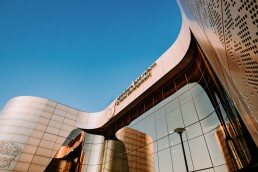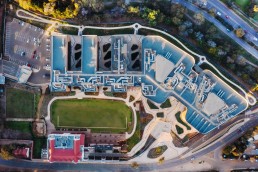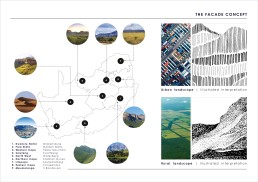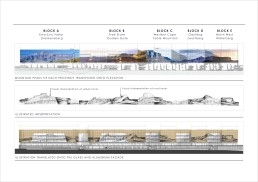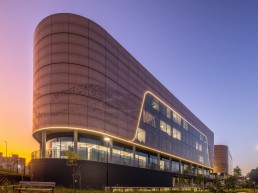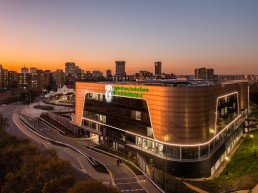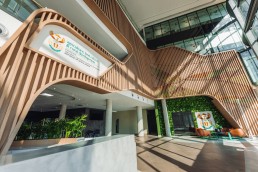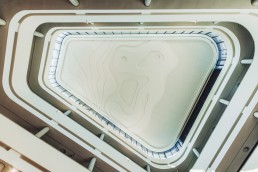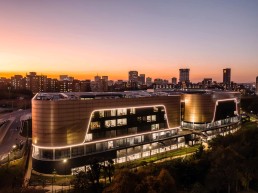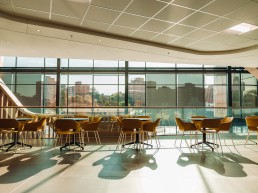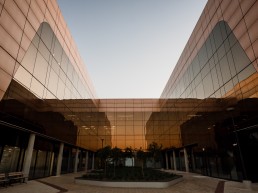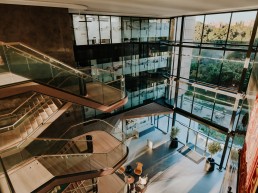Eleven years in the making, the new home of the Department of Agriculture, Land Reform and Rural Development (DALRRD) in South Africa’s capital city, Pretoria, adds a glittering landmark to the city’s (and the country’s) tradition of civic architecture.
Designed less to dazzle than to serve as a powerful symbol of the department’s central commitment to “secure a better quality of life for all”, the new building’s design arises from the foundational principles of its vision and values that reach back to the seminal statement in the Freedom Charter: “South Africa belongs to all those who live in it.” The new building represents the diversity, inclusiveness and distinctiveness of all South Africa’s people and their connection to its beautiful and varied topographies.
The central design concept was inspired by the land itself, which lies at the very heart of the department’s activities: agriculture, forestry, rural development, and land reform. The curved, organic shapes of the building and its low-slung form take their cue from shapes moulded by nature itself. The architecture quite literally hugs the ground rather towering vertically over it, almost as a refined or abstracted landform itself. Its edges rise and fall like curves and carved hollows sculpted by natural forces. Its dimensions and scale, too, are intentionally respectful of its context, with the city and the Magaliesberg mountain range forming its backdrop.
The building consists of five nodes or wings leading off a central spine that bends along with a curve in the Apies River, which runs along the edge of the site. This long, low form creates the wide floorplates that facilitate a light, open, friendly, hospitable and spatially connected environment in line with the department’s values of inclusivity and progressive organisational culture.
The distinctive identity of the building, however, is most emphatically defined by its shimmering façade, which is essentially an artwork in its own right: a complex unitised design of individually machined metallic materials and glass surfaces etched with a powerfully symbolic design. The envelope becomes a canvas for a large-scale image that wraps around the building.
The concept for the facade artwork of the Department of Agriculture, Rural Development and Land Reform building is derived from the fusion of various landscapes, specifically focusing on patterns found within urban and rural landscapes. The primary goal was to create an artwork which unifies and visualises the various focuses of the department: agriculture, forestry, rural development and land reform. For this reason, the facade artwork draws inspiration from the aesthetic qualities of South African landscapes and natural surroundings. The artwork makes use of linear and pointillist patterns which are laser cut out of the facade’s surface panels. When viewed closely, the artwork appears to be a unification of different forms and lines. However, when viewed from afar, the facade artwork forms one composition that depicts landscapes from South Africa’s nine provinces. These landscape interpretations are placed across the south, east and west facades of the building. These provinces, as listed below, provided distinct visual qualities. In connection to this, the illustration combines a linear and pointillist stylistic technique as to mimic patterns found in urban and rural landscapes. Examples of such patterns can be seen in the reference images below. The use of a linework approach creates visual reference to urban South African landscapes, whereas the pointillist approach signifies rural South African landscapes.
While the glint of the metallic finish makes reference to the mineral wealth beneath the ground, its copper and golden colour is drawn primarily from the rich ochre tones of the soil that is endemic to many parts of the country. The Highveld’s golden sunsets after its famous summer thunderstorms introduce an atmospheric dimension to the range of potential associations. The façade’s shimmering finish enhances the effect of the building’s fluid lines, adding dynamism and variance to its appearance, constantly refreshing its appeal.
The design of the artwork that wraps the buildings draws on the natural beauty of South Africa’s vast and varied landscapes. Profiles of the most iconic mountain peaks from each of the country’s nine provinces are fused together to create an image of a unified landscape that encompasses the whole country. It has been abstracted to make a pointillist design, which in turn has been executed as a perforated pattern on the metallic façade, assembled from the painstakingly positioned units that make up the facade.
Similarly, a linear design approach, which appears on the glass facades, signifies the urban landscapes of the country. This glass surface slips behind the skirts of the golden façade as it rises and falls. These two representations meld into a symbolic depiction of South Africa’s urban and rural landscapes intercepting each other, ultimately forming a unified symbolic representation of the whole country. All South Africans find themselves and their love of the land represented in this giant artwork, symbolising their connection and their right to the land, and signifying the department’s embrace of all the country’s people and landscapes.
Significantly, the pointillist and linear patterning of the designs was informed by traditional South African craft and artistic techniques such as beading and basketry. These techniques, variations of which are shared among local cultures, have been transformed into minimalistic design elements – the dots extrapolated from beadwork, the lines from weaving patterns – thus not only introducing a human dimension to the narrative of the peoples’ relationship with the land, but also presenting a fusion of tradition and cutting-edge technology: a vision of a modern future rooted in local heritage.
The glass facades facilitate a powerful connection between the interior of the building and its context, looking out over the landscaped grounds, over the city and to the mountain ranges beyond. The vision that informed the architecture and façade design is sustained in the interior spaces, blurring the distinction between the exterior and interior design of the building, welcoming diversity and emphasising the presence of the land in the inner workings of the department, too.
The colours, patterns, forms and textures of the country’s topography are expressed in elements throughout the building, from the atriums to the office spaces. Details designed into the bulkheads, ceiling finishes, floor tiles, timber screens, elements of the joinery and panelling, and even the shape of the planters, all celebrate the natural beauty of the country’s landscapes.
The graphic design of elements such as the wallpaper and the remarkable vinyl decals that feature on the walls at key points, such as the ground floor main entrance, are drawn from the patterns created by agricultural endeavour and human interaction with the land: the crop circles, furrows, terraces and rows that shape the land have, once again, been abstracted, simplified and transformed to become graphic design elements in a larger, unified composition.
Outside, the landscape design employs plantings of locally grown crops and vegetables such as maize, which at points come right up to the building edges, forming a base and making a symbolic connection where landscape and architecture meet.
The new home of the DALRRD is informed at every point in its design by its primary purpose, which is to secure a better quality of life for all. It is at once mindful of the need to be inclusive, broadly representative, respectful and welcoming to the needs of all who the department seeks to serve, and makes a powerful symbolic statement, representing the vision and aspirations of a country and its people through its connection to the land. Far from prescriptive, however, this building’s architecture is designed to allow its occupants to evolve and adapt with the changing times, facilitating its endeavours and enabling the department’s mandate well into the future.
